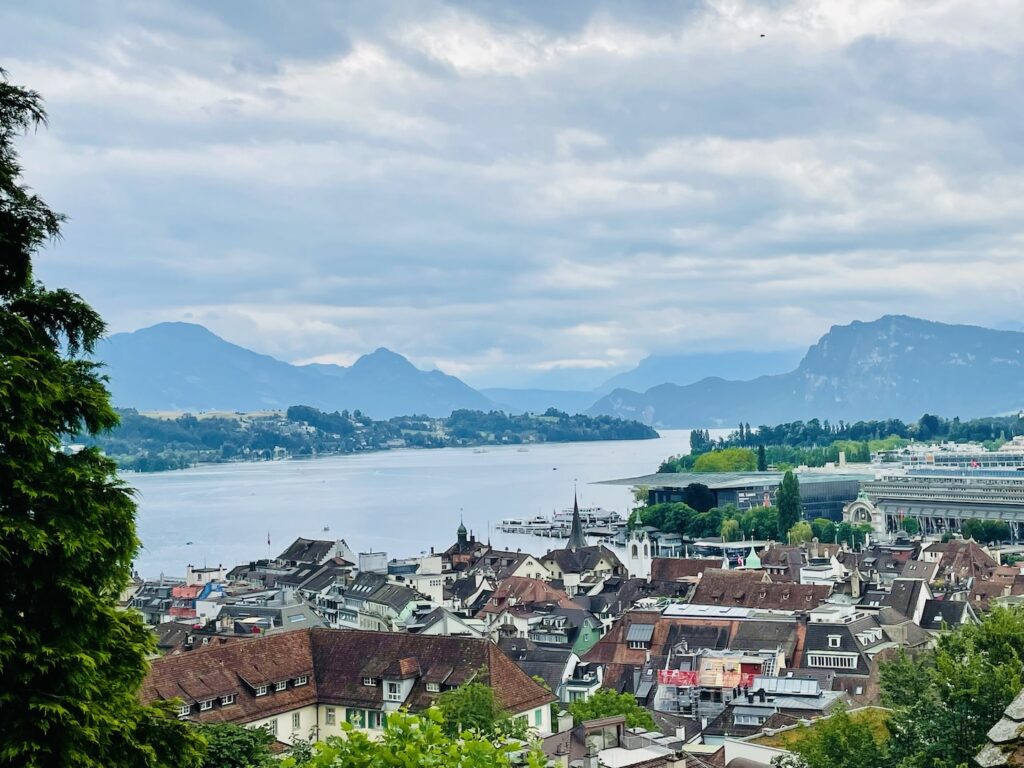The capital of Bavaria and home to the hugely popular annual Oktoberfest, Munich is a treasure to explore. The Altstadt (Old Town) is very walkable, and the notable surrounding sites make Munich such a pleasure to visit. The five areas and sites profiled in this article are perennial favorites for visitors. It all starts in Marienplatz, THE square, a lively place for tourists and locals alike. My husband and I spent a few days in Munich and enjoyed the variety of experiences, including palaces, museums, expansive parks, and (of course) beer gardens.
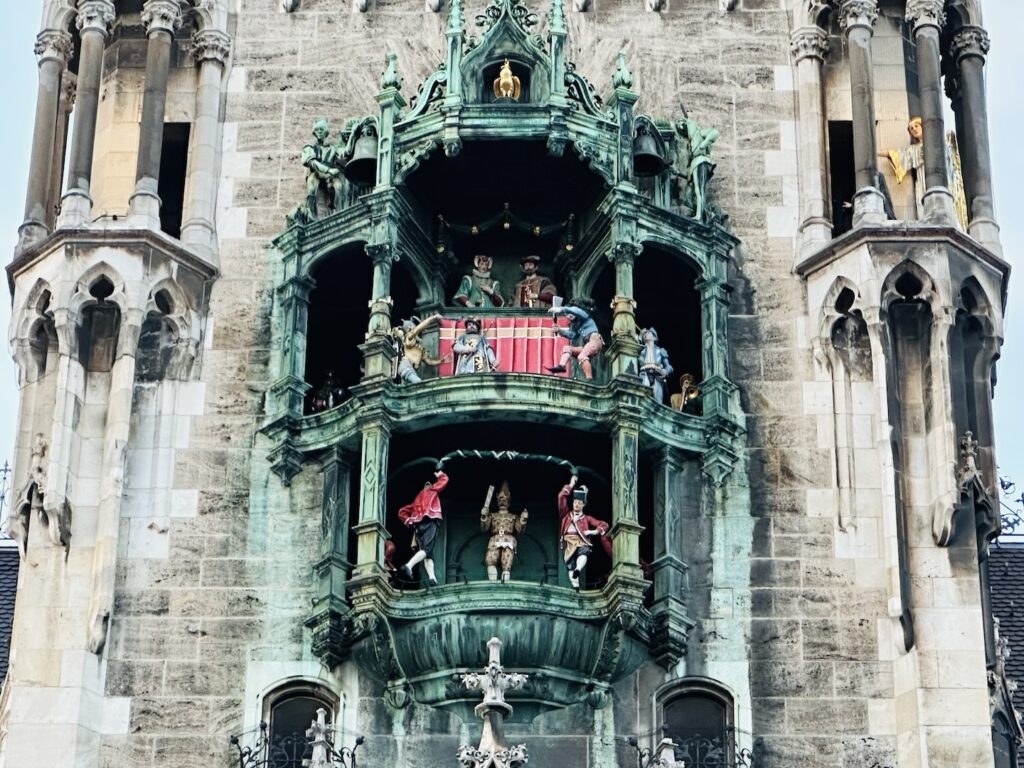
1. Marienplatz Area
Marienplatz is the hub of Munich’s Altstadt (Old Town). People gather here for many reasons, including to watch and listen to the Glockenspiel in the New Town Hall and to climb one or both of the towers (in New Town Hall and St. Peter’s Church) to catch 360-degree views of the city and beyond. It seems that there’s always something happening in Marienplatz. For instance, when we were there, a group of adults (and some kids) were in a circle kicking around a soccer ball. As time passed, they encouraged onlookers to join them, attracting even more people. Adjacent to Marienplatz, Kaufingerstrasse, and Neuhauser Strasse are two large pedestrian-only streets with boutiques, large chain stores, tourist shops, and eateries. During Advent, people flock to Marienplatz for the famous Christmas market.
From Marienplatz, it’s a short walk to the massive and opulent Residenz Palace, home to the Wittelsbach family for generations, and to wander through Viktualienmarkt, an outdoor market featuring produce stalls, a beer garden, flower shop, sandwich shops, and restaurants.
New Town Hall (Neues Rathaus)
Located in Marienplatz, the New Town Hall is massive and dominates Marienplatz. Built in the Neo-Gothic style, it houses hundreds of city employees. Besides being a place of municipal employment, the New Town Hall has:
- an observation tower offering panoramic city views is open daily from 10:00 am to 8:00 pm. Tickets (about €6.50) are available online and at the town hall.
- a law library with gilded spiral staircases.
- the famed balcony where sports teams celebrate achieving titles.
- a Glockenspiel, a giant mechanical clock with 43 bells and 32 life-size figures. It’s been a mainstay attraction since 1908 when the Neues Rathaus (New Town Hall) was completed. (Today, the Glockenspiel is powered by solar energy.)
The building’s exterior holds figures symbolic of the city, past rulers, and a dragon foretelling the plague. Look up high for the statue of the city’s symbol, the Münchner Kindl (Munich child), who oversees the land. Guided tours are available in English on Saturday afternoons for about €18. It’s best to check the current tour hours and book ahead.
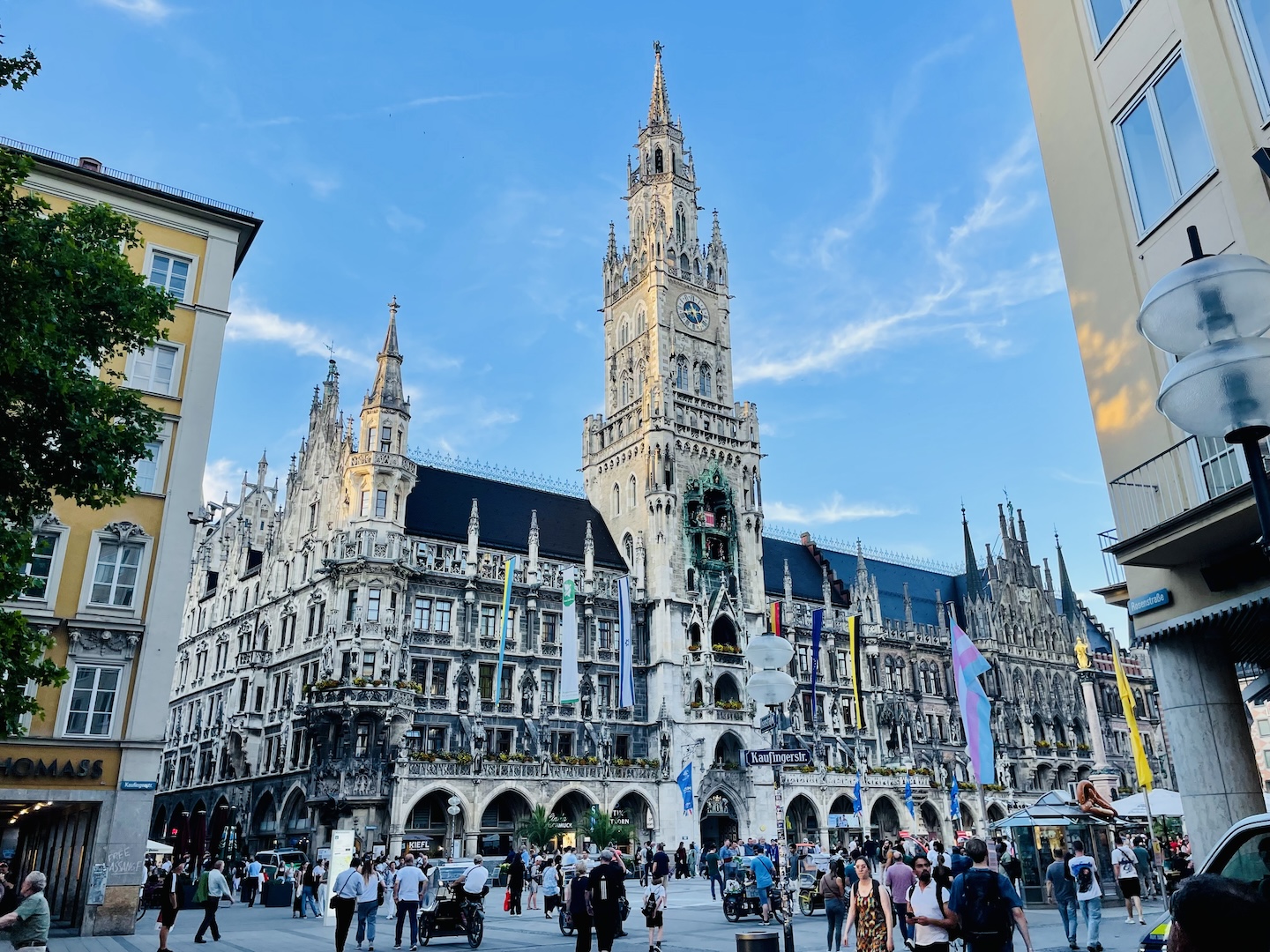
Glockenspiel Performances
Its performances can be viewed at 11:00 a.m. and 12:00 p.m. year-round. From March to October, there’s also a 5:00 p.m. performance.
The Glockenspiel’s performance chronicles the marriage of Duke Wilhelm IV of Bavaria to Renata of Lorraine, a French noblewoman, in 1568. Expect some knight-jousting action. Following that, there is the dance of coopers (barrel makers) who, legend has it, went through the town following the 1517 plague, urging residents to come out of their homes since it was then safe to do so. The performances last about 15 minutes and conclude with a small golden rooster chirping three times.
St. Peter’s Church (Peterskirsche)
Built in the 12th century, St. Peter’s Church is the oldest place of worship in the city and sits just off of Marienplatz. The ornate interior features a golden statue of St. Peter at the altar.
St. Peter’s Church Tower
Attached to the church is a tower – locally dubbed “Alt Peter” (Old Peter) – with 306 steps leading to a viewing platform with magnificent city views for those who make the climb. The tower entrance is outside the church. There’s a nominal admission fee (we paid €5 each) for the tower; there’s no entry fee for the church. The tower is open from April to October from 9:00 am to 7:30 pm; November to March from 9:00 am to 6:30 pm. Petersplatz 1
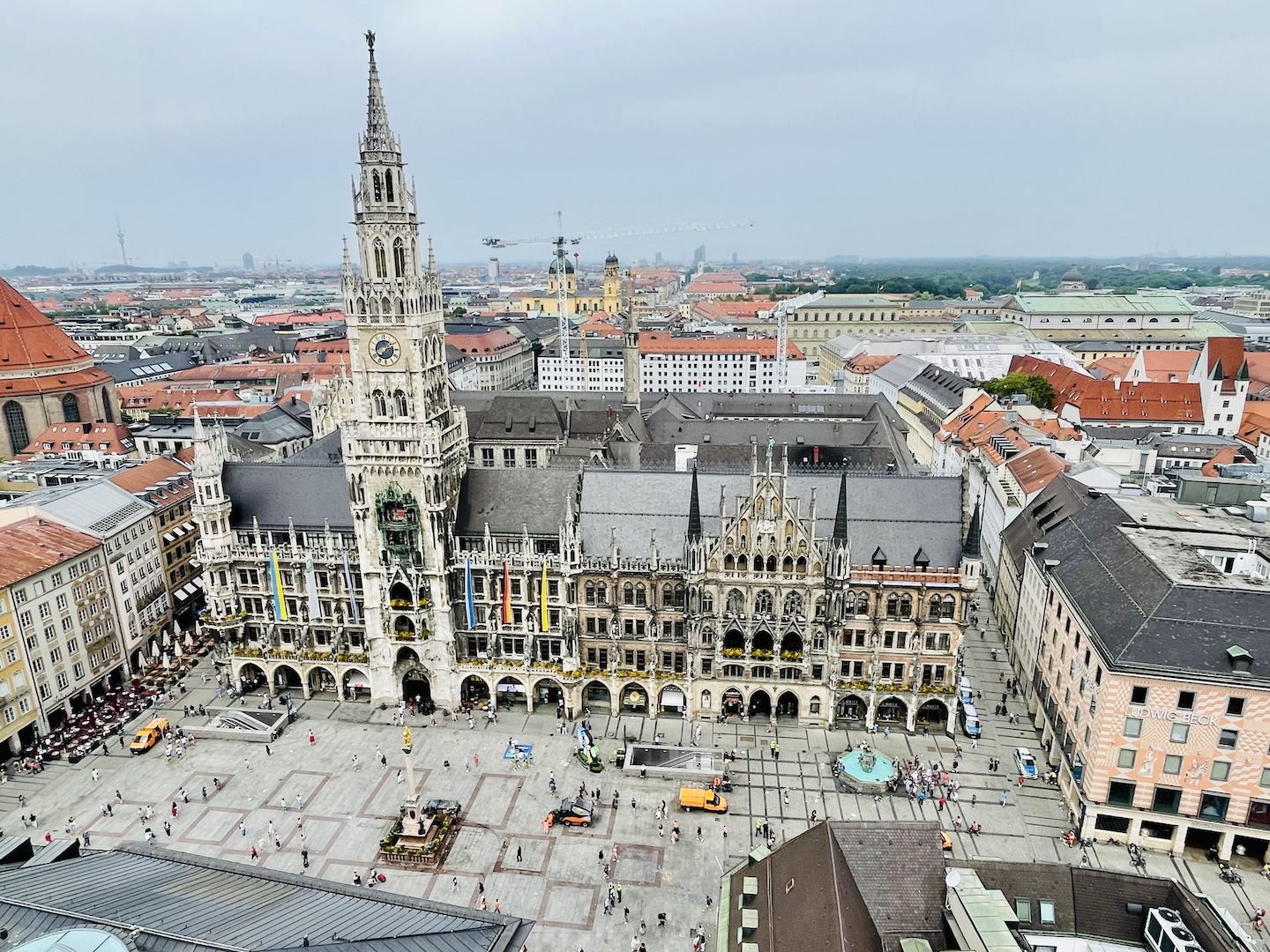
Residence (Residenz)
The Residenz Palace (Residence) was the main palace and government seat of the Wittelsbachs from 1508 to 1918. The Wittelsbachs began as Bavarian dukes, became electors in 1623, and finally rose to kings in 1806. The Residenz has been a museum since 1920. This palace complex has over 100 rooms, representing a variety of architectural styles and 400 years of building and renovating.
In addition to taking a self-guided tour through the Residenz, visitors can visit the Treasury, which includes displays, golden gem-studded crowns, crystal, and religious artifacts.
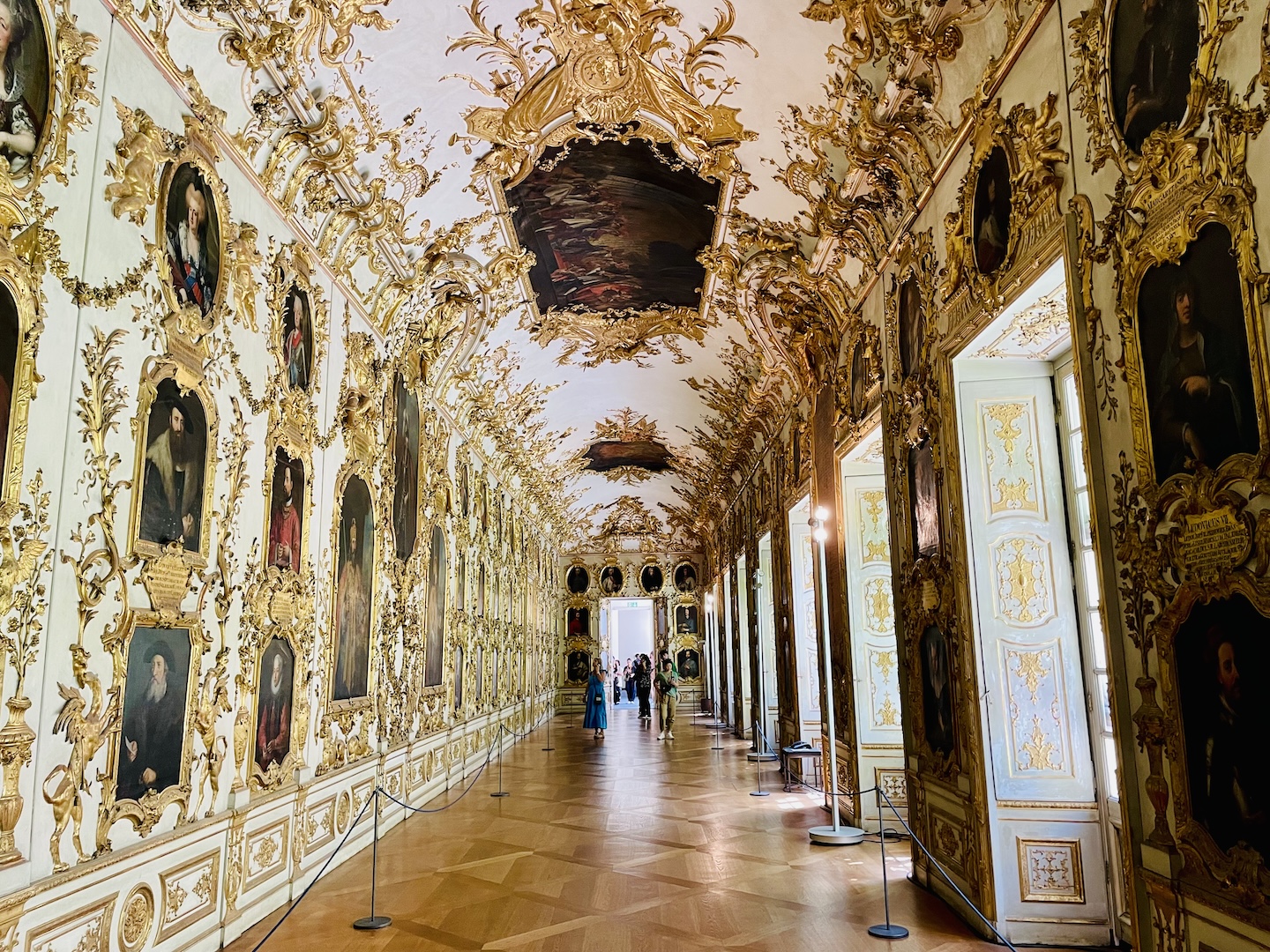
Tours are self-guided; free audio guides are available. Open mid-March to mid-October, daily from 9:00 am to 6:00 pm; mid-October to mid-March from 10:00 am to 5:00 pm. Admission charged. Residenzstrasse 1
Hofgarten
The Hofgarten (“Court Garden”) is between the Residenz and the large urban English Garden. After visiting the Residenz, take a relaxing walk through the Hofgarten.
Viktualienmarkt
Since the 1880s, Viktualienmarkt has been a popular market with about 140 vendors selling something for just about everyone. There are fruit and vegetable vendors, bakeries, butchers, cafés and restaurants, florists, and a beer garden here. Merchants set their own hours, but most are open from 8:00 am to early evening Monday through Saturday. Viktualienmarkt is conveniently located steps from Marienplatz. It’s fun to stroll through the market, look at all the goods, admire the many fountains dedicated to performing legends, and perhaps stop for refreshments. There’s more local flair at Viktualienmarkt, like a Maypole depicting symbols of Bavaria, erected by Munich’s breweries in the 1960s.
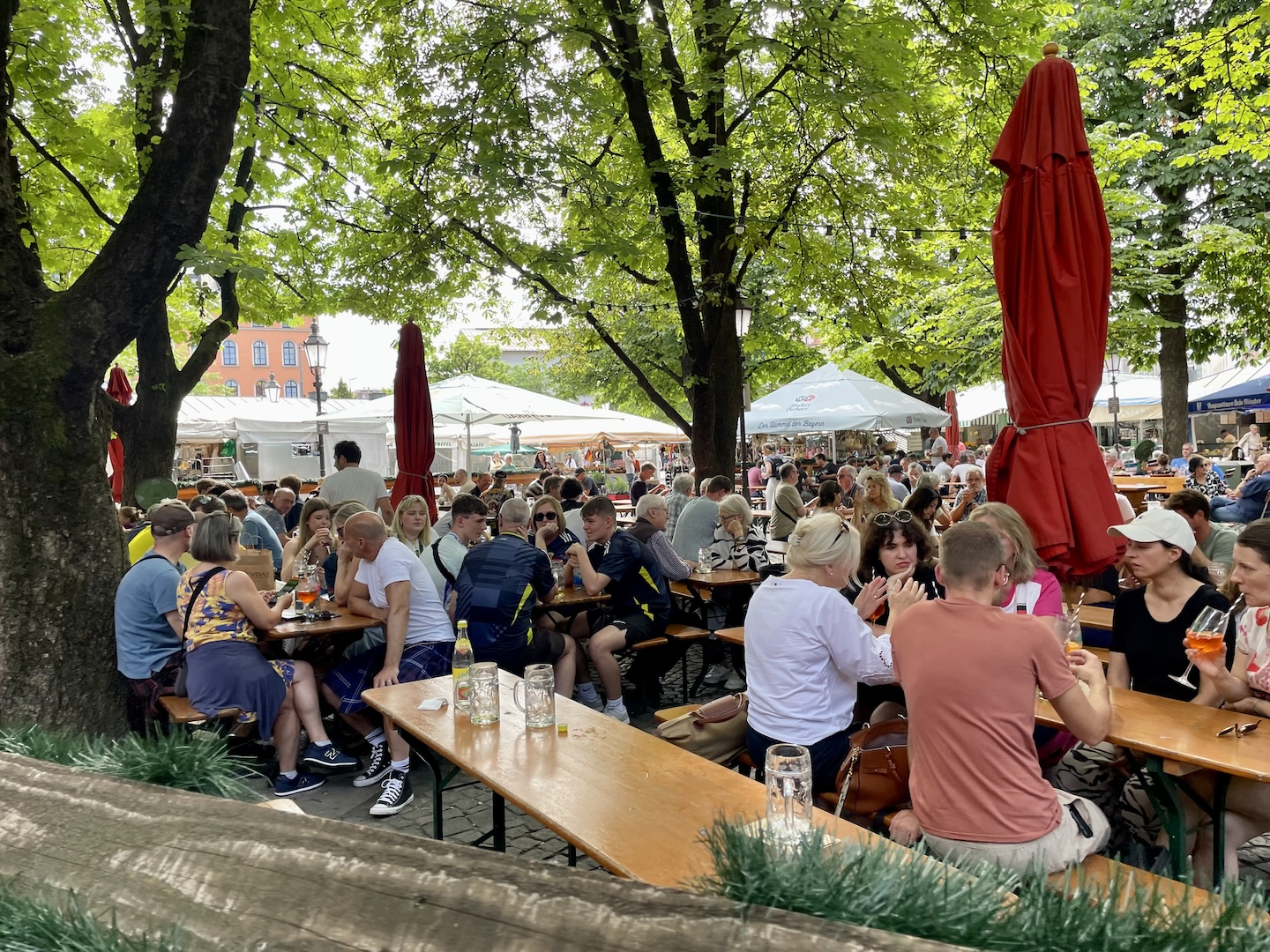
2. BMW Welt and Museum
BMW Welt (BMW World) and the BMW Museum are adjacent to each other and offer a variety of exhibits, displays, and events for car enthusiasts. In addition to the BMW brand, there are MINI and Rolls-Royce models. Events include racing simulations, dance lessons, yoga sessions, and more. BMW Welt is free and open Monday to Saturday: 7:30 am to 12 midnight; Sundays: 9:00 am to 12 midnight.
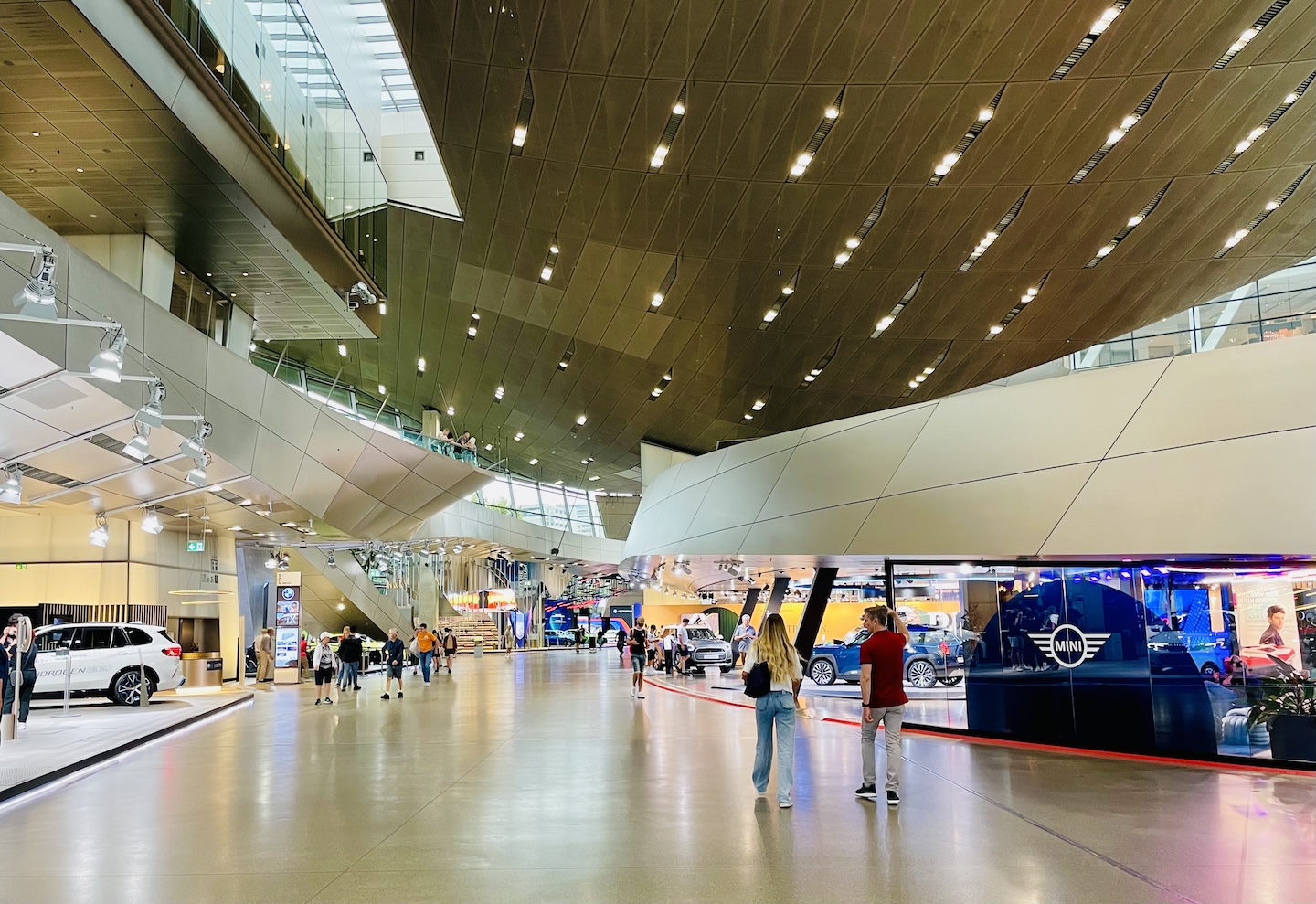
There are shops and restaurants onsite. BMW Museum has an admission charge and is open Tuesday to Sunday: 10:00 am – 6:00 pm. This complex is northwest of the Altstadt (old town) and easily accessed by taxi, ride-share, or public transportation. Am Olympiapark 1,
3. English Garden (Englischer Garten)
The sprawling English Garden (Englischer Garten) is 1.4 square miles/3.7 square km and borders the old town. It was designed in the 18th century in the tradition of an English landscape park.
Within this massive urban park are plenty of open green spaces and:
- dozens of miles of paths and trails for walking, jogging, and bicycling.
- water features, including a lake where row and pedal boats can be rented.
- four beer gardens (each featuring a different brand).
- a hilltop Greek-style temple (Monopteros).
- a Chinese tower (Chinesischer Turm), a five-story structure that sometimes houses an oompah band to entertain those gathered at one of the beer gardens.
- the Eisbach River, an arm of the Isar River.
- a river surfing area created by a stationary man-made wave. It’s located along the edge of the English Garden (on Prinzregentenstrasse opposite number 22). Experienced surfers try their best on the Eisbach Wave (Eisbachwelle), waiting for their turns to jump on their surfboards and test the waters. There’s an unwritten code among the surfers: to respect other surfers, take turns, don’t hog the wave, and give the right of way to swimmers traversing the stream.
- a nude sunbathing area, the Schönfeldwiese.
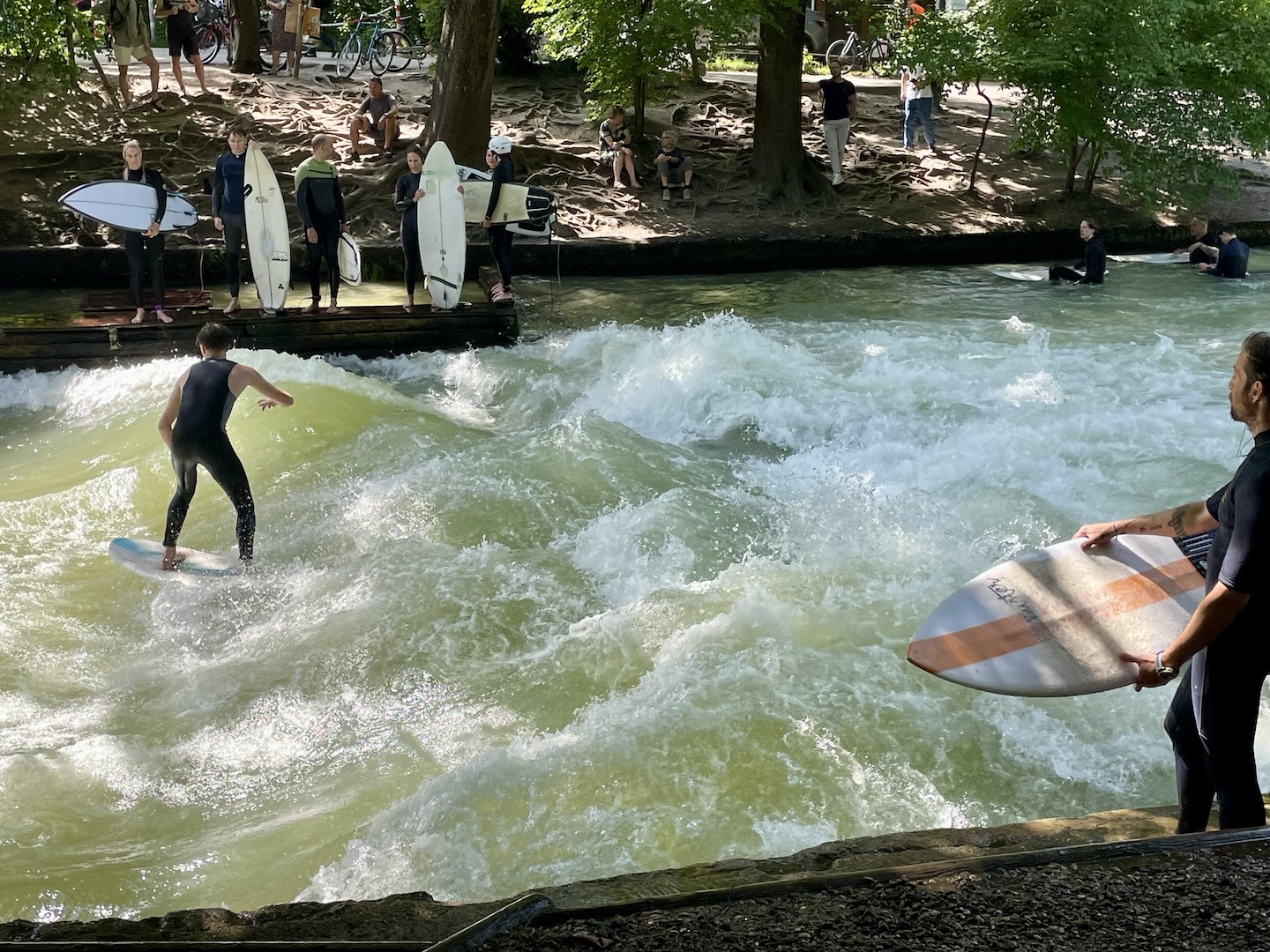
4. Nymphenburg Palace (Schloss Nymphenburg)
Just outside the historic center of Munich is Nymphenburg Palace (“Castle of the Nymphs”), a Baroque structure that was a favorite summer residence for Bavarian rulers. Nymphenburg Palace was built in 1664 following the birth of Max Emanuel, son of Elector Ferdinand Maria of Bavaria and Henriette Adelaide of Savoy. It was enlarged over successive decades and centuries and remained a popular summer retreat for Bavarian rulers.
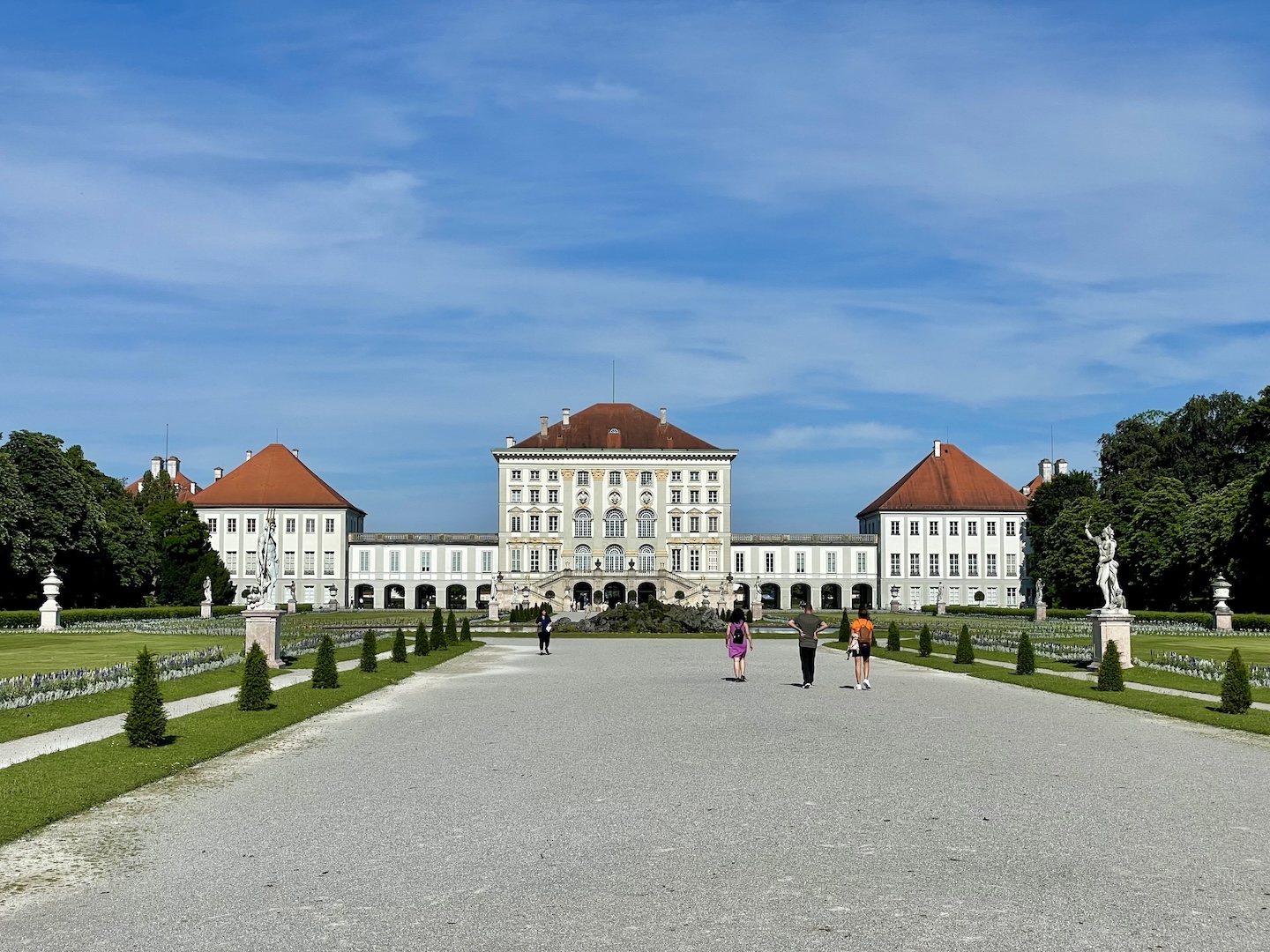
Today, it’s a delight to visit. Stroll through the palace, trails in the surrounding bucolic Nymphenburg Park, plus specialty buildings like the Marstallmuseum (museum of royal carriages) and a hunting lodge. There’s a bistro and gift shop onsite. Nymphenburg Palace is located west of the city, and it is about a 25-minute ride via taxi or ride-share. Schloss Nymphenburg, Eingang 19
5. Olympic Park (Olympiapark Munich)
Home to the 1972 Olympics, this venue offers guided tours of the stadium as well as the Tent Roof Tour and the Flying Fox, a zip slide across the stadium. The Olympic tents are acrylic and designed to represent the peaks of the Alps. Olympic Park is northwest of the Altstadt (old town) and easily accessed by taxi, ride-share, or public transportation. Spiridon-Louis-Ring 21
Tips for Visiting Munich
- The Euro is the currency in Germany. Converter+ and XE are popular apps for converting currency. Learn about other great travel apps in my article Must-Have Travel Apps and Websites.
- Most museums in Munich are closed on Mondays, although the Nymphenburg Palace and the Residenz are open.
- The tourist information website has a complete list of popular sites and events.
- The Munich Card and Munich City Pass offer discounts at museums, palaces, and public transportation.
- Search online (or use TripAdvisor or a similar site) for walking and specialty guided tours that suit your interests.
- Taxis and ride-share services are readily available in Munich. We were pleased with the taxi and Uber rides we had. However, I prefer Uber since I can track the ride, pay, and tip within the app.
Where to Stay and Eat
Where to Stay
My husband and I can recommend two hotels. Both are just a few minutes’ walk from Marienplatz (from opposite directions).
First, Living Hotel at Viktualienmarkt (Living Hotel Das Viktualienmarkt – München) is across the street from Viktualienmarkt, the outdoor market with restaurants, shops, flower marts, and a lively buzz. One benefit we enjoyed at Living Hotel was the free self-serve laundry facilities on the lower level of the hotel – a great plus while traveling. There’s a small bar and restaurant onsite. Frauenstrasse 4, Munich
Second, Hotel Vier Jahreszeiten Kempinski is a large luxury hotel on Maximillianstrasse, near the Residenz Palace (now a museum). Across the street are stores filled with luxury brand items from Cartier, Montblanc, Hermes, and the like. Its guest rooms are very comfortable, with a large relaxing lobby, a bar, and a restaurant. Maximilianstraße 17
Where to Drink and Eat
Munich Beer
Munich’s big six beer producers are Hofbräu, Löwenbräu, Augustiner, Paulaner, Hacker-Pschorr, and Spaten-Franziskaner. Munich has strict regulations about what ingredients will be used in beer production. Unlike other German cities, Munich allows visitors to bring food into beer gardens. The drinking age for beer in Munich is 16. One must be 18 for other alcohol consumption.
Beer Gardens (Biergartens)
Three beer gardens that we recommend are Augistineer-Keller (about 1.2 miles/2 km from Marienplatz), Hofbräuhaus (about a 5-minute walk from Marienplatz), and the Hofbräu beer garden by the Chinesicher Turm (Chinese Tower), one of several beer gardens in the English Garden. The beer garden in the English Garden we visited serves Hofbräu beer and hearty food. Choose your food and beer, find a table in the garden, and enjoy the traditional ambiance that often includes a German oompah band. When ordering beer, you’ll be paying for it and a deposit on the glass beer stein. When you’re finished, take the tokens and your empty beer steins to the returns area to claim your glass deposit when turning in your steins. As mentioned, there are other beer gardens in the English Garden; each site serves different beer brands. Plus, there’s also a beer garden in Viktualienmarkt, which is just a few minutes walk from Marienplatz.
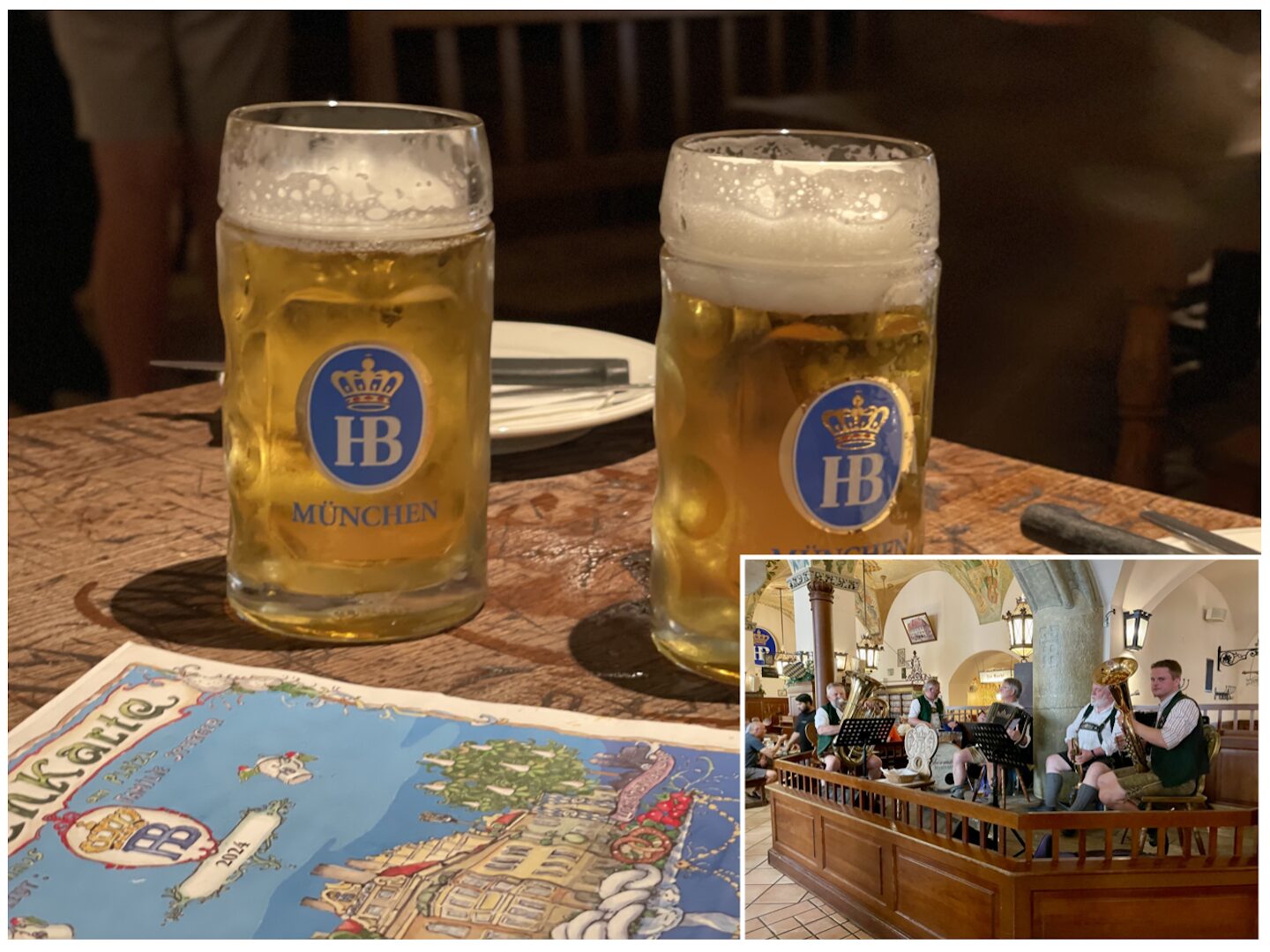
Eatery Suggestions
As you’d imagine, there is a wealth of dining options, from casual cafés or bistros with outdoor seating (great for people-watching) to refined dining. My husband and I chose beer gardens and a few other places for our meals, including relaxing Hochreiter’s Steirer am Markt, with indoor and outside seating, in Viktualienmarkt.
Besides the beer gardens (that we thought were “must do’s” in Bavaria), Café-Bistro Dallmayr (Dienerstrasse 14-15) is perfect for breakfast or lunch. You’ll have a delicious, leisurely meal with attentive service. The café is on the second floor; when you enter the building, you’ll be able to wander through the impressive Dallmayr Delikatessenhaus, a delicatessen with an ample assortment of meats, cheeses, pastries, chocolates, wine, and quite a bit more. Second is Hochreiter in the Viktualienmarkt (across and down from the beer garden) for lunch or dinner. Eat inside or outside; It offers tasty food, a full bar, and friendly service.
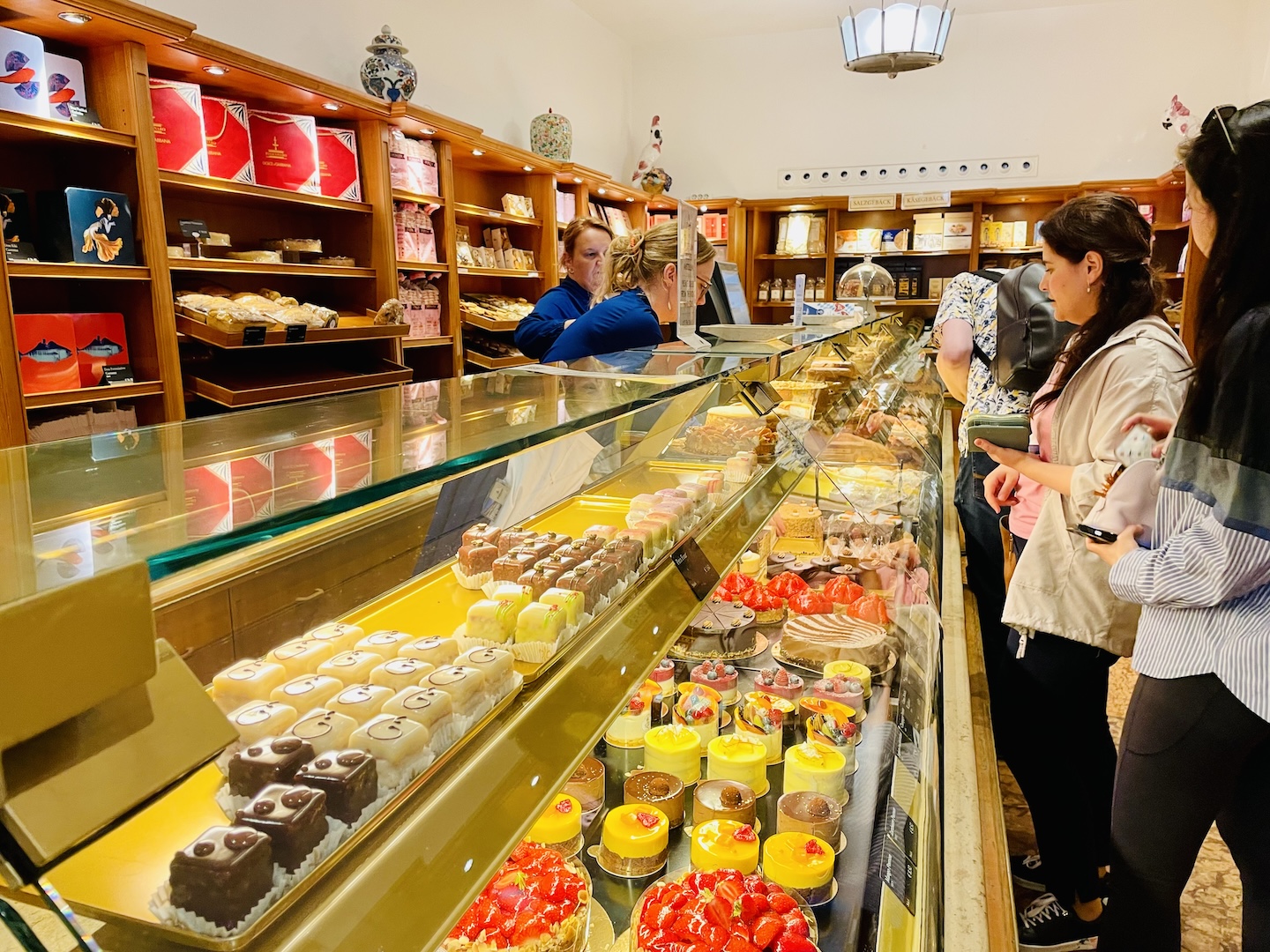
German Sausage Specialty
Another Munich specialty (besides beer) is the Münchner Weißwürste, a thick sausage with a white casing usually eaten with mustard. A German friend schooled me in how to eat these thick sausages like a local. Her directions: “Insert a fork into the middle of the sausage for stability. With a knife, carefully slice the casing of the sausage from tip to tip (along the entire length of the sausage). Then, wedge your knife between the casing and the sausage and carefully push outward to unwrap/peel out the sausage meat. It sounds more complicated than it actually is. The casing usually comes off easily.”
Related Articles
Germany & Austria
- Berchtesgaden, Germany: Kehlsteinhaus (“Eagle’s Nest), Germany, A Unique Experience with Impressive Mountaintop Vistas
- Munich, Germany: Nymphenburg Palace, A Must-See Munich Treasure
- Munich, Germany: Residenz Palace, Bavarian Opulence on Full Display
- Salzburg, Austria: The Best Experiences in this Picturesque Alpine City
Trip Planning
- Design Perfect Trip Itineraries — On Your Own or with AI
- Driving in Europe: What You Need to Know
- Expert Tips for Traveling to Europe for More Fun, Less Stress
- How to Plan a Great Trip
- Renting a Car in Europe
- Stay Powered Up: A Traveler’s Guide to Power Banks
- Travel Lightly: Top Ten Tips to Pack for Your Next Trip
- Travel Planning Timeline
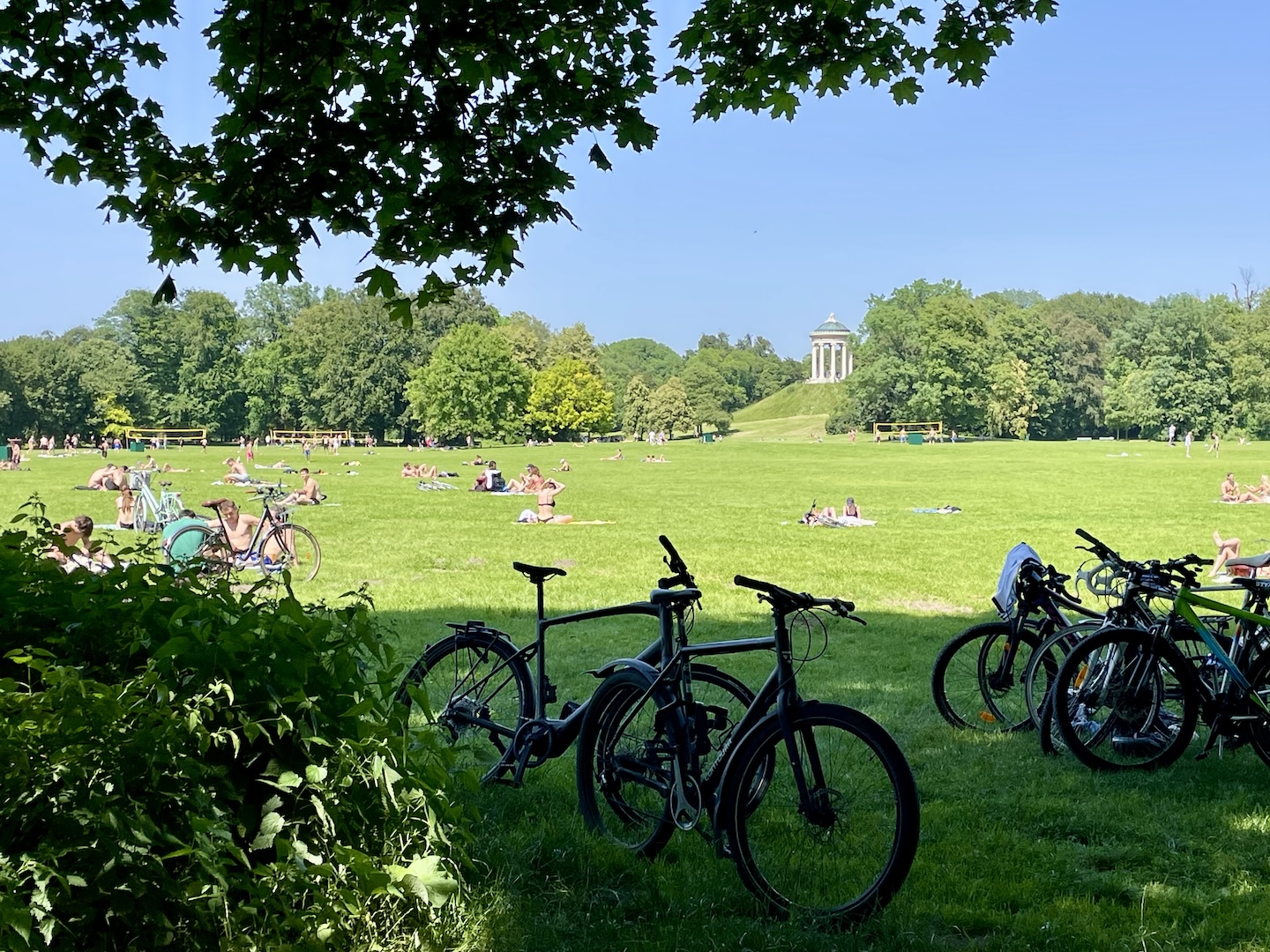
Final Thoughts
My husband and I enjoyed our few days in Munich. We took a walking tour of the old part of the city to orient ourselves before setting out independently, climbing St. Peter’s Tower, visiting the Residenz Palace, and strolling through Viktualienmarkt. One day, we ventured by Uber to visit Nymphenburg Palace. What’s great about the city is that it’s a very relaxing place to explore, going at our own pace, and people are so welcoming. This beautiful city demands at least three or four days to get the most out of it.
Comments?
Feel free to share your experiences in Munich and/or suggestions for other places to visit. Your ideas could be helpful to other travelers. Thanks! 🙂

